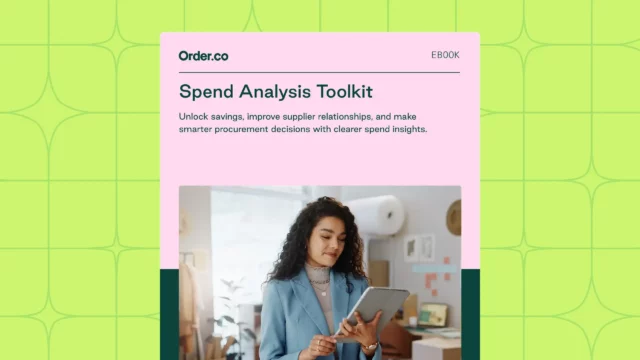How to Achieve 100% Spend Visibility: A 3-Step Guide

How to Achieve 100% Spend Visibility: A 3-Step Guide
For finance and operations leaders at growing businesses, tracking every dollar is non-negotiable. Yet, true visibility often feels just out of reach. Spend happens everywhere—on corporate cards, through invoices from hundreds of vendors, and as unapproved purchases that only surface on expense reports weeks later. This chaos of decentralized buying makes it nearly impossible to answer a simple question: "Where is our money really going?"
Achieving 100% spend visibility is the solution, but it requires moving beyond reactive, manual processes. It’s essential to leverage a system that gives you complete insight and control over company spending before it happens, not just after. The path to total visibility rests on three core pillars: automating data capture at the source, achieving granular detail on every purchase, and enabling proactive control with live budgets.
This guide provides an operational roadmap to surface spend that usually lives outside your core systems. By implementing these three steps, you can transform your purchasing process from a chaotic cost center into a streamlined, intelligent engine for growth.
Download the free ebook: Spend Analysis Toolkit
Why is spend visibility so hard to achieve?
Spend visibility is difficult because purchasing is often decentralized, manual, and happens across disparate systems, creating data silos and blind spots. When every team, department, and location has its own way of buying, finance is left to piece together a financial puzzle with incomplete information. This leads to lagging data, wasted time, and missed opportunities for savings.
The primary challenges that obscure your view of company spending include:
- Decentralized purchasing: Employees use a mix of corporate cards, personal credit cards for reimbursement, and direct vendor invoices. This creates multiple sources of spend data that are difficult to consolidate and analyze, leading to a fragmented view of cash flow.
- Manual data entry: Accounts payable teams spend countless hours manually keying in invoice details and assigning GL codes. This process is not only slow and expensive but also prone to human error, which compromises the accuracy of your financial data and delays the month-end close process.
- Lack of granularity: A credit card statement might show a $1,000 charge to a major online retailer, but it won’t tell you what was actually purchased. Without line-level spend visibility, you can't identify redundant purchases, enforce brand standards, or spot opportunities for vendor consolidation.
- Maverick spending: Also known as rogue spend, these are purchases made outside of approved channels and processes. This maverick spending is completely invisible to finance until an invoice or expense report appears, making budget enforcement impossible.
Step 1: Automate GL coding at the point of purchase
Leveraging a unified procurement system with GL code automation at the point of purchase ensures every transaction is categorized correctly from the start, eliminating manual work, preventing errors, and speeding up financial reporting. Instead of waiting for an invoice to arrive, you capture and code spend data the moment a purchase is initiated.
The problem with manual GL coding
Traditionally, GL coding is a reactive, back-office function. The AP team receives an invoice and must determine the correct department, location, and expense account based on limited information. This manual approach is fundamentally flawed.
It’s a time-consuming and tedious task that pulls your finance team away from more strategic work. Worse, it’s often a guessing game. An invoice for "office supplies" could be for the marketing team's event materials or the new hire kits for HR. Incorrect coding leads to inaccurate budget reports and flawed financial forecasting, hindering strategic decision-making.
How to automate GL coding before the purchase
The solution is to shift GL coding from a post-purchase task to a pre-purchase step. Using a centralized purchasing platform, you can pre-assign GL codes to specific products, vendors, and departments.
Here’s how it works in a modern procurement platform:
- Set up your rules: Finance teams configure coding rules within the system. For example, all purchases of "printer paper" from a specific vendor can be automatically assigned to GL code 6510 (Office Supplies) for the "Operations" department.
- Guide the user: When an employee needs to buy something, they log into a single, guided marketplace. They can only see and purchase pre-approved items.
- Code automatically: As the employee adds an item to their cart, the system automatically applies the correct GL code based on the pre-set rules. The coding is done before the order is even submitted for approval.
With a platform like Order.co, this entire process is automated. Because all purchases originate within the system, every transaction is automatically and accurately coded before it occurs. This eliminates manual data entry, ensures consistency, and provides clean, reliable data that syncs directly to your ERP. The platform then syncs a consolidated invoice containing all purchasing data directly to NetSuite or your accounting system to accelerate reconciliation.
Step 2: Capture line-level data for true spend clarity
Achieving line-level spend visibility means seeing every individual item on every purchase—not just the total amount. This granular detail is essential for understanding purchasing behavior, enforcing policies, and unlocking strategic cost-saving opportunities.
The limitations of summary-level data
Most spend management tools provide summary-level data. A corporate card statement tells you where money was spent and how much, but not on what. This lack of detail creates significant blind spots.
Without line-level data, you can't perform a meaningful spend analysis. You might see that your company spends $50,000 per month with a single big-box supplier, but you have no way of knowing if those purchases are strategic or wasteful. Are teams buying premium-brand items when a more cost-effective alternative exists? Are different locations buying the same products from different vendors at different prices? Summary-level data leaves these critical questions unanswered.
The path to granular, line-level visibility
True line-level spend visibility is only possible when you centralize purchasing through a single platform that captures every item at the point of order. While some AP automation tools use Optical Character Recognition (OCR) to scan invoices, this method is often unreliable and still happens after the fact.
Order.co provides line-level data by design. Because every purchase—from office supplies and IT equipment to marketing swag and operational goods—is made through its unified marketplace, the platform captures 100% of the item-level detail. This gives you unprecedented insight into your organization’s spending habits.
With this level of granularity, you can:
- Identify savings opportunities: Discover that five different departments are buying five different models of black pens and consolidate the purchases to a single, preferred SKU to leverage volume discounts. Order.co’s AI-powered strategic sourcing can even recommend cost-effective alternatives in real time, helping you save an average of 5% in cash back rewards.
- Enforce compliance: Ensure that multi-location businesses maintain brand consistency by curating catalogs with pre-approved products, whether it's specific coffee for a hotel lobby or standardized furniture for a new office.
- Optimize inventory: Track consumption patterns for consumables across all locations to prevent stockouts and reduce excess stock.
This detailed data transforms procurement from a simple administrative function into a strategic tool for identifying savings opportunities and driving efficiency.
Step 3: Implement live budgets for real-time control
Live budgets provide a real-time budget vs. actuals view, allowing finance leaders to track spending as it happens and proactively prevent overspending. This shifts budget management from a reactive, historical reporting exercise to a proactive, forward-looking control mechanism.
The pitfalls of lagging budget reports
Traditional budgeting is broken. Finance teams set annual or quarterly budgets, but they can only measure performance against those budgets by looking backward. By the time the books are closed and reports are generated, the spending has already occurred. If a department went over budget, it’s too late to course correct.
This lag time between when money is spent and when it’s reported creates a major control gap. It forces finance leaders into the role of scorekeeper, reporting on what already happened instead of shaping what will happen. It also creates friction, as budget owners may not even be aware they are approaching their limit until it's too late.
How to enable real-time budget vs. actuals tracking
The key to proactive budget control is a procure-to-pay solution that connects purchasing directly to your budgets. Instead of tracking spend after invoices are paid, you track it as purchase requests are made and approved.
A system with live budget controls allows you to:
- Set granular budgets: Assign budgets to specific departments, locations, projects, or even GL codes for a defined period.
- Track spend in real time: As employees add items to their carts and submit orders for approval, the platform automatically checks the purchase amount against the relevant budget.
- Automate enforcement: Create custom approval workflows that are triggered by budget thresholds. For example, any purchase that puts a department over 80% of its monthly budget could automatically route to the VP of Finance for an additional layer of approval.
Order.co's platform provides this dynamic, real-time budget vs. actuals tracking. Budget owners and finance teams can see the impact of a purchase before it’s approved, allowing for informed, proactive decisions. This empowers department heads to manage their own budgets effectively while giving finance the ultimate control and visibility needed to prevent overspending.
Bringing it all together: The power of a unified P2P platform
The only way to achieve true 100% spend visibility is with a unified procure-to-pay automation platform that combines automated GL coding, line-level data capture, and live budgets in one seamless system. Disparate point solutions that only handle expenses, cards, or invoices will always leave you with blind spots.
By managing the entire purchase-to-pay process in a single place, you create a single source of truth for all company spending.
- Automated GL coding ensures your data is accurate and structured from the very beginning.
- Line-level data capture provides the deep insights needed for strategic analysis and cost control.
- Live budget tracking gives you the real-time control to enforce policies and prevent overspending proactively.
While other tools focus on managing spend after it happens, Order.co is the only platform that addresses spend at its origin: the point of purchase. By centralizing every request, approval, order, and payment, it provides a level of visibility and control that other systems can't match. The platform’s unified catalog makes clunky vendor punchouts obsolete, and automated workflows ensure that every dollar spent is on-policy, on-budget, and fully accounted for.
Gain total control of your company’s spending
Moving from fragmented, reactive financial operations to a unified, proactive system is the key to unlocking 100% spend visibility. By automating GL coding, capturing line-level detail, and implementing live budgets, you can eliminate manual work, control costs, and empower your teams to make smarter financial decisions.
If you’re ready to bring order to the chaos of business buying and gain complete control over your spend, it’s time to see what a true end-to-end platform can do.
Schedule a demo to see how Order.co can simplify buying for your business.
Get started
Schedule a demo to see how Order.co can simplify buying for your business.
"*" indicates required fields



